 W
WThe Battle of Agincourt was an English victory in the Hundred Years' War. It took place on 25 October 1415 near Azincourt, in northern France. The unexpected English victory against the numerically superior French army boosted English morale and prestige, crippled France and started a new period of English dominance in the war.
 W
WThe Battle of Ardres was fought on 6 June 1351 between French and English forces near the town of Ardres, Pas de Calais during the Hundred Years War. The French won.
 W
WThe Battle of Auberoche was fought on 21 October 1345 during the Gascon campaign of 1345 between an Anglo-Gascon force of 1,200 men under Henry, Earl of Derby, and a French army of 7,000 commanded by Louis of Poitiers. It was fought at the village of Auberoche near Périgueux in northern Aquitaine. At the time, Gascony was a territory of the English Crown and the "English" army included a large proportion of native Gascons. The battle resulted in a heavy defeat for the French, who suffered very high casualties, with their leaders killed or captured.
 W
WThe Battle of Auray took place on 29 September 1364 at the French town of Auray. This battle was the decisive confrontation of the Breton War of Succession, a part of the Hundred Years' War.
 W
WThe Battle of Blackpool Sands was the result of an attempted French raid on the port of Dartmouth, South Devon, England, in April or May 1404. Local forces defeated the raiders, taking a number of prisoners and killing the French commander, William du Chastel.
 W
WThe Battle of Baugé, fought between the English and a Franco-Scots army on 22 March 1421 at Baugé, France, east of Angers, was a major defeat for the English in the Hundred Years' War. The English army was led by the king's brother Thomas, Duke of Clarence, while the Franco-Scots were led by both John Stewart, Earl of Buchan, and Gilbert Motier de La Fayette, the Marshal of France. English strength was 4,000 men, although only 1,500 deployed, against 5,000 French and Scots.
 W
WThe Battle of Beaugency took place on 16 and 17 June 1429. It was one of Joan of Arc's battles. Shortly after relieving the siege at Orléans, French forces recaptured the neighboring district along the Loire river. This campaign was the first sustained French offensive in a generation during the Hundred Years' War.
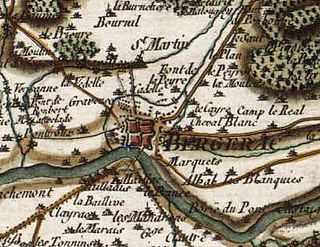 W
WThe Battle of Bergerac was fought between Anglo-Gascon and French forces at the town of Bergerac in Gascony, in August 1345 during the Hundred Years' War. In early 1345 Edward III of England decided to launch a major attack on the French from the north, while sending smaller forces to Brittany and Gascony, the latter being both economically important to the English war effort and the proximate cause of the war. The French focused on the threat to northern France, leaving comparatively small forces in the south west.
 W
WBlack Monday took place on Easter Monday (1360) during the Hundred Years' War (1337–60), when a freak hail storm struck and killed an estimated 1,000 English soldiers. The storm was so devastating that it caused more English casualties than any of the previous battles of the war.
 W
WThe Black Prince's chevauchée of 1356, which began on 4 August at Bordeaux and ended with the Battle of Poitiers on 19 September, was a devastating raid of Edward of Woodstock, Prince of Wales, the eldest son of King Edward III of England. This expedition of the Black Prince devastated large parts of Bergerac, Périgord, Nontronnais, Confolentais, Nord-Ouest, Limousin, La Marche, Boischaut, Champagne Berrichonne, Berry, Sologne, south of Touraine and Poitou.
 W
WThe Battle of Blanchetaque was fought on 24 August 1346 between an English army under King Edward III and a French force commanded by Godemar du Fay. The battle was part of the Crécy campaign, which took place during the early stages of the Hundred Years' War. After landing in the Cotentin Peninsula on 12 July, the English army had burnt a path of destruction through some of the richest lands in France to within 20 miles (32 km) of Paris, sacking a number of towns on the way. The English then marched north, hoping to link up with an allied Flemish army which had invaded from Flanders. They were outmanoeuvred by the French king, Philip VI, who garrisoned all of the bridges and fords over the River Somme and followed the English with his own field army. The area had previously been stripped of food stocks by the French, and the English were essentially trapped.
 W
WThe siege of Breteuil was the investment of the Norman town of Breteuil, held by partisans of Charles II, King of Navarre, by French forces. It lasted from April to about 20 August 1346. It was interrupted on 5 July when a small English army commanded by Henry, Earl of Lancaster relieved and resupplied it. The French king, John II attempted to bring Lancaster to battle with the much larger French royal army, but Lancaster marched away and the attempt failed. John then renewed the siege of Breteuil.
 W
WThe Battle of Cadzand was an early skirmish of the Hundred Years' War fought in 1337. It consisted of a raid on the Flemish island of Cadzand, designed to provoke a reaction and battle from the local garrison and so improve morale in England and amongst King Edward III's continental allies by providing his army with an easy victory. On 9 November Sir Walter Manny, with the advance troops for Edward III's continental invasion, made an attempt to take the city of Sluys, but was driven off.
 W
WThe Battle of Caen was an assault conducted on 26 July 1346 by forces from the Kingdom of England, led by King Edward III, on the French-held town of Caen and Normandy as a part of the Hundred Years' War.
 W
WThe Battle of Calais took place in 1350 when an English force defeated an unsuspecting French army which was attempting to take the city. Despite a truce being in effect the French commander Geoffrey de Charny had planned to take the city by subterfuge, and bribed Amerigo of Pavia, an Italian officer of the city garrison, to open a gate for them. The English king, Edward III, became aware of the plot and personally led his household knights and the Calais garrison in a surprise counter-attack. The French were routed by this smaller force, with significant losses and all their leaders captured or killed.
 W
WThe Battle of Castillon took place on 17 July 1453 in Gascony near the town of Castillon-sur-Dordogne, between England and France. Historians regard this decisive French victory as marking the end of the Hundred Years' War.
 W
WThe Battle of Cravant was fought on 31 July 1423, during the Hundred Years' War between English and French forces at the village of Cravant in Burgundy, at a bridge and ford on the banks of the river Yonne, a left-bank tributary of the Seine, southeast of Auxerre. The battle ended in a victory for the English and their Burgundian allies.
 W
WThe Battle of Crécy took place on 26 August 1346 in northern France between a French army commanded by King Philip VI and an English army led by King Edward III. The French attacked the English while they were traversing northern France during the Hundred Years' War, resulting in an English victory and heavy loss of life among the French.
 W
WThe Crécy campaign was a series of large-scale raids (chevauchées) conducted by the Kingdom of England throughout northern France in 1346 that devastated the French countryside on a wide front, culminating in the eponymous Battle of Crécy. The campaign was part of the Hundred Years' War.
 W
WThe Battle of Formigny, fought on 15 April 1450, was a major battle of the Hundred Years' War between the kingdom of England and the kingdom of France. The destruction of England's last army in Normandy in the battle and the decisive French victory paved the way for the capture of the remaining English strongholds in Normandy.
 W
WThe Battle of Gerberoy was fought in 1435 between French and English forces. The French were led by La Hire and Jean Poton de Xaintrailles, who were victorious. The English losses were heavy, which later included their commander, John FitzAlan, 14th Earl of Arundel.
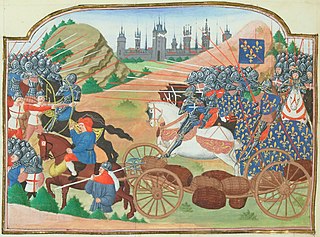 W
WThe Battle of the Herrings, also called the Battle of Rouvray, was a military action near the town of Rouvray in France, just north of Orléans, which took place on 12 February 1429 during the siege of Orléans in the Hundred Years' War. The immediate cause of the battle was an attempt by French and Scottish forces, led by Charles of Bourbon and Sir John Stewart of Darnley, to intercept a supply convoy headed for the English army at Orléans. The English had been laying siege to the city since the previous October. This supply convoy was escorted by an English force under Sir John Fastolf and had been outfitted in Paris, whence it had departed some time earlier. The battle was decisively won by the English.
 W
WThe Battle of Jargeau took place on 11–12 June 1429. It was part of the Loire Campaign during the Hundred Years' War, where Charles VII's forces successfully recaptured much of the region following their victory at the siege of Orleans. The battle ended in victory for Charles VII and is notable as Joan of Arc's first offensive battle.
 W
WThe Battle of La Brossinière or Battle of la Gravelle was a battle of the Hundred Years' War on 26 September 1423. It occurred at La Brossinière, between the forces of England and France, shortly after hostilities had resumed, following the battle of Agincourt (1415).
 W
WThe Battle of La Roche-Derrien was one of the battles of the Breton War of Succession; it was fought on 20th June 1347 during the night between English and French forces. Approximately 4,000–5,000 French, Breton and Genoese mercenaries laid siege to the town of La Roche-Derrien in the hope of luring Sir Thomas Dagworth, the commander of the only standing English field army in Brittany at the time, into an open pitched battle.
 W
WLancaster's chevauchée of 1346 was a series of offensives directed by Henry, Earl of Lancaster, in southwestern France during autumn 1346, as a part of the Hundred Years' War.
 W
WThe Loire Campaign was a campaign launched by Joan of Arc during the Hundred Years' War. The Loire was cleared of all English and Burgundian troops.
 W
WThe Battle of Margate, also known as the Battle of Cadzand, was a naval battle that took place 24–25 March 1387 during the Caroline War phase of the Hundred Years' War between an English fleet and a Franco-Castilian-Flemish wine fleet.
 W
WThe Battle of Meung-sur-Loire took place on 15 June 1429. It was one of Joan of Arc's battles following relief of the siege at Orléans. This campaign was the second sustained French offensive in a generation in the Hundred Years' War.
 W
WThe Battle of Montiel was a battle fought on 14 March 1369 between the Franco-Castilian forces supporting Henry of Trastámara and the Granadian-Castilian forces supporting the reigning Peter of Castile.
 W
WThe Battle of Morlaix was a battle fought in Morlaix on 30 September 1342 between England and France. The English besieged the town, but a French relief force arrived. The English constructed a strong defensive position. After repeated attacks, the French forced the English to retreat into the woods, and the French force then withdrew. Notably it was the first use of a tactical withdrawal by the English in medieval warfare.
 W
WThe Battle of Nájera, also known as the Battle of Navarrete, was fought on 3 April 1367 near Nájera, in the province of La Rioja, Castile. It was an episode of the first Castilian Civil War which confronted King Peter of Castile with his half-brother Count Henry of Trastámara who aspired to the throne; the war involved Castile in the Hundred Years' War. Castilian naval power, far superior to that of France or England, encouraged the two polities to take sides in the civil war, to gain control over the Castilian fleet.
 W
WThe Battle of Neville's Cross took place during the Second War of Scottish Independence on 17 October 1346, half a mile to the west of Durham, England. An invading Scottish army of 12,000 led by King David II was defeated with heavy loss by an English army of approximately 6,000–7,000 men led by Ralph Neville, Lord Neville. The battle was named after an Anglo-Saxon stone cross that stood on the hill where the Scots made their stand. After the victory, Neville paid to have a new cross erected to commemorate the day.
 W
WThe Battle of Patay was the culminating engagement of the Loire Campaign of the Hundred Years' War between the French and English in north-central France. The French cavalry inflicted a severe defeat on the English. Many of the English knights and men-at-arms on horses were able to escape but crippling losses were inflicted on a corps of English longbowmen, which was not reconstituted after the battle. This victory was to the French what Agincourt was to the English. Although credited to Joan of Arc, most of the fighting was done by the vanguard of the French army as English units fled, and the main portions of the French army were unable to catch up to the vanguard as it continued to pursue the English for several miles.
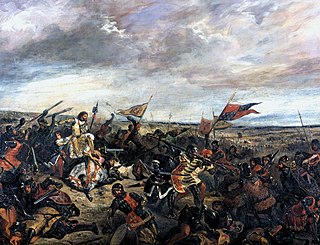 W
WThe Battle of Poitiers was a major English victory in the Hundred Years' War. It was fought on 19 September 1356 in Nouaillé, near the city of Poitiers in Aquitaine, western France. Edward, the Black Prince, led an army of English, Welsh, Breton and Gascon troops, many of them veterans of the Battle of Crécy. They were attacked by a larger French force led by King John II of France, which included allied Scottish forces. The French were heavily defeated; an English counter-attack captured King John, along with his youngest son, and much of the French nobility who were present.
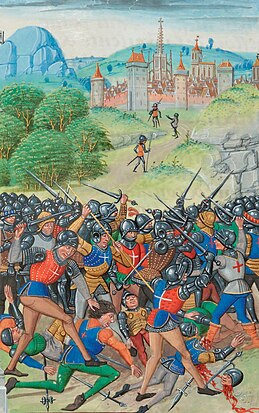 W
WThe Battle of Pontvallain, part of the Hundred Years' War, took place in the Sarthe region of north-west France on 4 December 1370, when a French army under Bertrand du Guesclin heavily defeated an English force which had broken away from an army commanded by Sir Robert Knolles. The French numbered 5,200 men, and the English force was approximately the same size.
 W
WAfter the lifting of the Siege of Orléans and the decisive French victory at the Battle of Patay, the Anglo-Burgundian threat was ended. Joan of Arc convinced the Dauphin Charles to go to be crowned at Reims. The march though the heart of territory controlled by the hostile Burgundians was successful and would give the throne of the French monarchy to Charles VII, who had been ousted therefrom by the Treaty of Troyes.
 W
WThe Siege of Saint-Jean-d'Angély took place from February to August 1351 when a French army besieged an English garrison within the town of Saint-Jean-d'Angély, Saintonge, France during the Hundred Years' War. An English relief force was victorious at the Battle of Saintes, however was unable to relieve the town. With the personal appearance of King John II of France at the siege, the English garrison surrendered.
 W
WThe Battle of Saint-Omer, fought on 26 July 1340, was a major engagement which occurred in the early stages of the Hundred Years' War. It was a part of King Edward III's summer campaign against France launched from Flanders. The campaign was initiated in the aftermath of the Battle of Sluys but turned out to be far less successful than he hoped. At Saint-Omer, in an unexpected turn of events, the heavily outnumbered French men-at-arms, tasked with defending the city and awaiting for reinforcements, defeated the Anglo-Flemish forces on their own. The Allies suffered heavy losses and the French captured their camp intact, taking many warhorses and carts, all the tents, huge quantities of stores and most of the Flemish standards. Edward's campaign of 1340 had begun badly. On the bright side, the loss of several thousand men was bearable, as the survivors, which included most of the precious English longbowmen, eventually rejoined him at Tournai. The defeat had serious strategic consequences. It exposed southern Flanders to the wrath of Philip VI and enabled the French to concentrate their forces against the main army of the coalition in the Tournaisis.
 W
WThe Battle of Saintes was fought on 1 April 1351 during the Hundred Years' War between French and English forces. The French were besieging the town of Saint-Jean-d'Angély when an English relief force arrived. The English force was victorious, but the battle was not able to force the end of the siege of Saint-Jean-d'Angély, which fell to the French on 31 August.
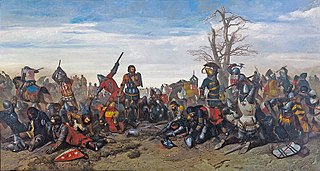 W
WThe Combat of the Thirty, occurring on 26 March 1351, was an episode in the Breton War of Succession fought to determine who would rule the Duchy of Brittany. It was an arranged fight between selected combatants from both sides of the conflict, fought at a site midway between the Breton castles of Josselin and Ploërmel among 30 champions, knights, and squires on each side. The challenge was issued by Jean de Beaumanoir, a captain of Charles of Blois supported by King Philip VI of France, to Robert Bemborough, a captain of Jean de Montfort supported by Edward III of England.
 W
WThe Battle of Verneuil was a battle of the Hundred Years' War, fought on 17 August 1424 near Verneuil in Normandy. The battle was a significant English victory. It was a particularly bloody battle, described by the English as a second Agincourt.
 W
WThe Battle of Winchelsea or the Battle of Les Espagnols sur Mer was a naval battle that took place on 29 August 1350 and was a victory for an English fleet of 50 ships, commanded by King Edward III, over a Castilian fleet of 47 larger vessels, commanded by Charles de La Cerda. Between 14 and 26 Castilian ships were captured, and several were sunk. Only two English vessels were sunk, but there was a significant loss of life. The battle was part of the Hundred Years' War between England and France.